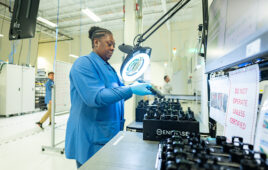By Paul Grana, co-founder of Folsom Labs
We previously showed that over-power clipping losses are not nearly as high as people typically think. A commercial system in Atlanta with a DC/AC ratio of 1.3 would have just 0.5% of over-power clipping loss. However, that analysis just looked at one location. We find that the results will change significantly based on where the array is located. And that not only will the system performance change, but it can lead to differences in system design from one location to another.
Sunlight (and clipping) varies by location
We chose Atlanta because it was middle-of-the-road in terms of sunlight received. If we look at other cities that are popular for solar, we can see that annual sunlight ranges from over 2,100 W/m2 in Phoenix to just over 1,100 W/m2 in Seattle. Of course, this isn’t exactly news that Arizona gets more sun than Washington does, but less obvious is the impact it has on over-power clipping losses. To visualize this, we can organize the number of hours spent at each level of sunlight intensity.
Of course, this isn’t exactly news that Arizona gets more sun than Washington does, but less obvious is the impact it has on over-power clipping losses. To visualize this, we can organize the number of hours spent at each level of sunlight intensity.
The intensity of sunlight has a close relationship to clipping losses. A system clips when the DC power is larger than the inverter’s rated output power, so the number of hours that a system spends at or near its peak output determines how much energy will be lost due to clipping. Note how many hours Phoenix has at peak production—a full 200 hours where the modules are receiving more than 1,000 W/m2! As a result, the clipping losses in Phoenix are nearly twice that of the arrays in Atlanta or Seattle.
Impact on optimal system design
This relationship between sunlight and clipping loss doesn’t just change the energy calculations. It has implications for the optimal system design that an engineer will implement.
For example, if a designer has a target of 1.5% clipping loss, this would result in a 1.3 DC-to-AC ratio in Phoenix, and a 1.45 DC-to-AC ratio in Spokane. A designer in Washington could save ~15% on inverter costs compared to the same designer in Arizona, and maintain the identical system efficiency.
Ultimately, a designer assembling systems in a range of locations is likely to end up with a different inverter-to-array sizing at each location. And the upside of designing in low-irradiance locations like Boston or Seattle is that you can save a bit of money on inverter costs!






Hi everyone – I live in the Phoenix, Arizona area, and my installer put in 34x340W (11.56kWh) panels coupled with a SolarEdge SE7600 (7.6kWh) inverter…this works out to 1.52 to 1.00 DC to AC power feeding the inverter. The salesperson informed me when he sold me the system that I was purchasing the maximum number of panels for my 200A service breaker box… I was fine with this, as I didn’t want to increase the size of my breaker box. The salesperson for this solar company never informed me that I would be losing power – or that the limiting factor would be the 7.6kW inverter (vs. the number of panels). I am clipping for 3-4 hours per day in September, and the best solar irradiation for Phoenix is March through August, so I can only imagine how bad this clipping will get. In addition, I have overheated my inverter whereby it “self-protects” and reduces power even more than the 7.6kWh. I believe the solar company did a horrible job matching the inverter design for this part of the country for the number of panels they sold me, and I feel as if they totally were out to make a fast buck on panels vs. sizing the inverter correctly for the job. It seems unconscionable to install 1.52 to 1.00 DC/AC ratio for Phoenix, and I think it should be no worse than 1.2 to 1.0 for an acceptable level of clipping. What do you think? They should have told me not to purchase as many panels, or that they would upgrade the service panel to 400A or they could have even downsized the main breaker to 175A to be able to put in a 60A circuit for the inverter and installed a more appropriately sized 11.4kWh inverter… I expected the solar company to have integrity and to put in the most effective/efficient system, but the inverter for Phoenix seems to be severely undersized. Am I the only one thinking this is completely wrong of the solar company?
Hi Kelsey,
I have a 14.28 kW system in phoenix with the 10k inverter (SE10000H). I was initially concerned about clipping. After 5 days I’ve seen clipping each day (we’ve had clear skies and cool weather).
I did some calculations and at 3.5 hours of clipping per day that’s about 12% loss.
I’m at 1.428:1 DC/AC ratio and I think this could be too much for phoenix. I’m going to reach out to my installer and see about the 11.4kW inverter (SE11400H). I feel like I’ll get the runaround and the 10k is within the SolarEdge specs (15.5k) 1.55:1.
I might also reach out to SolarEdge and get their input as well.
Am I clipping too much? I tend to think so. (but I’m very new to solar).
I have a SolarEdge 7.6 SE7600H-us inverter
38 300w Heliene panels 38 * 300w = 11.4kw
located in Longwood, FL 32779 (outside Orlando)
Yesterday, 4/11/2018, I clipped most of the day. On 3/22, 3/23, 3/24, 3/28 I clipped just about the entire day.
https://monitoringpublic.solaredge.com/solaredge-web/p/site/public?name=Emmons11.4kw&locale=en_US#/dashboard
Thank you, Mike
Hi Mike,
Your DC to AC ratio is 1.5, which is allowable for your 7.6kW HD Wave inverter (1.55 is the limit from SolarEdge). Your installer probably selected this inverter, rather than a larger one, in order to have a simple tie-in to a 40-Amp circuit breaker in the electrical service panel. Your clipping in Orlando is probably similar to Atlanta, or slightly higher, which from the graph in this article, appears to be a little over 3% per year at a ratio of 1.5. If you were in Phoenix, I would say your system as designed would probably clip too much at over 5% loss. In Orlando, it’s just a value decision taken by your installer. A larger inverter would cost you more both for the inverter itself as well as the work required to connect it to your electrical service (probably a line side tap, or service reconfiguration of some sort). Assuming your designer/installer considered those costs, they probably gave you the system with better payback, regardless of the clipping. Hopefully your installer gave you some details on expected monthly/annual energy production and payback. As long as your system is performing as expected, taking into account weather variations, I wouldn’t worry about it.
Regards,
-Hans
Also, the HD Wave inverter is more efficient than the older style SolarEdge inverters. So although you may be losing a percent or two due to clipping, you’re gaining a percent or so due to increased efficiency.